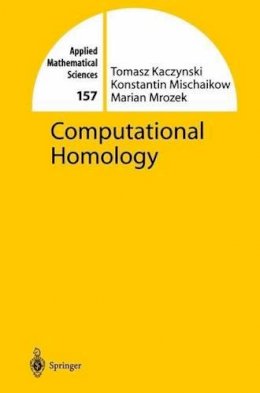
Stock image for illustration purposes only - book cover, edition or condition may vary.
Computational Homology (Applied Mathematical Sciences)
Tomasz Kaczynski
FREE Delivery in Ireland
Description for Computational Homology (Applied Mathematical Sciences)
Hardcover. Uses the computer to take a combinatorial computational approach to homological problems. This interdisciplinary book is aimed at researchers and students in mathematics, computer science, nonlinear dynamics, and engineering. Series: Applied Mathematical Sciences. Num Pages: 500 pages, biography. BIC Classification: PBPD. Category: (P) Professional & Vocational. Dimension: 234 x 156 x 28. Weight in Grams: 885.
Homology is a powerful tool used by mathematicians to study the properties of spaces and maps that are insensitive to small perturbations. This book uses a computer to develop a combinatorial computational approach to the subject. The core of the book deals with homology theory and its computation. Following this is a section containing extensions to further developments in algebraic topology, applications to computational dynamics, and applications to image processing. Included are exercises and software that can be used to compute homology groups and maps. The book will appeal to researchers and graduate students in mathematics, computer science, engineering, and nonlinear dynamics.
... Read moreShow Less
Product Details
Series
Applied Mathematical Sciences
Place of Publication
New York, NY, United States
Shipping Time
Usually ships in 15 to 20 working days
Reviews for Computational Homology (Applied Mathematical Sciences)
From the reviews: "...This is an interesting and unusual book written with the intention of serving several purposes. One of them is to demonstrate that methods of algebraic topology, in particular homology theory, that have proved remarkably successful in several areas of pure mathematics can provide powerful, and in some cases indispensable, tools in a number of areas ... Read moreof applied mathematics and science. The second is to provide the necessary theory and "technology" for such applications. This means on the one hand providing all the necessary mathematical foundations of the subject, including definitions and theorems, and on the other hand efficient computational techniques capable of dealing with real life situations. Thus, the book stresses algorithmic and computational approaches; and in fact includes computer code written in a programming language specially designed for this purpose. It is addressed to a varied audience of computer scientists, experimental scientists and engineers while at the same time trying to retain the interest of mathematicians. With this in mind the authors have attempted to produce a modular book, which allows a number of different reading approaches. The basic subdivision of the book is into three parts. The last part contains all the basic pre-requisites from algebra and topology: the most essential facts about Euclidean spaces, point set topology, abelian groups, vector spaces and matrix algebras. This part also contains a description of the programming language used to describe the algorithms found in the book..."
MATHEMATICAL REVIEWS "This is an interesting and unusual book with the intention of serving several purposes. One of them is to demonstrate that methods of algebraic topology, in particular homology theory … . The second is to provide the necessary theory and ‘technology’ for such applications. … the book admirably achieves all its stated purposes. In addition it will provide much neededammunition for those algebraic topologists who have been feeling besieged by allegations of their subject’s lack of ‘useful’ applications." (Andrzej Kozlowski, Mathematical Reviews, 2005g) "This book provides the conceptual background for computational homology – a powerful tool used to study the properties of spaces and maps that are insensitive to small perturbations. The material presented here is a unique combination of current research and classical rigor, computation and application." (Corina Mohorianu, Zentralblatt Mathematik, Vol. 1039 (8), 2004) "In addition to developing a computational homology theory which produces efficient algorithms, the authors demonstrate how these algorithms can be applied to a variety of problems … . I certainly recommend Computational Homology to mathematicians and applied scientists who wish to learn about the potential of algebraic topological methods. … this book is the first comprehensive effort to describe the computational aspects of homology theory … . It is written at a level that is suitable for advanced undergraduate and early graduate courses … ." (Thomas Wanner, SIAM Review, Vol. 48 (1). 2006) "This is the first textbook on what is necessarily a mixture of classical mathematics, computer science, and applications. … it is a unique feature of Computational Homology that every geometric step, however conceptually simple, is broken down into elementary operations. … The book offers a reliable yet practical introduction to (cubical homology), with a strong emphasis on computational aspects. Hands-on experience can be gained through the many problems within the book and also by means of the software packages … ." (Arno Berger, Zeitschrift für Angewandte Mathematik und Mechanik, Vol. 86 (4). 2006) Show Less

.png)